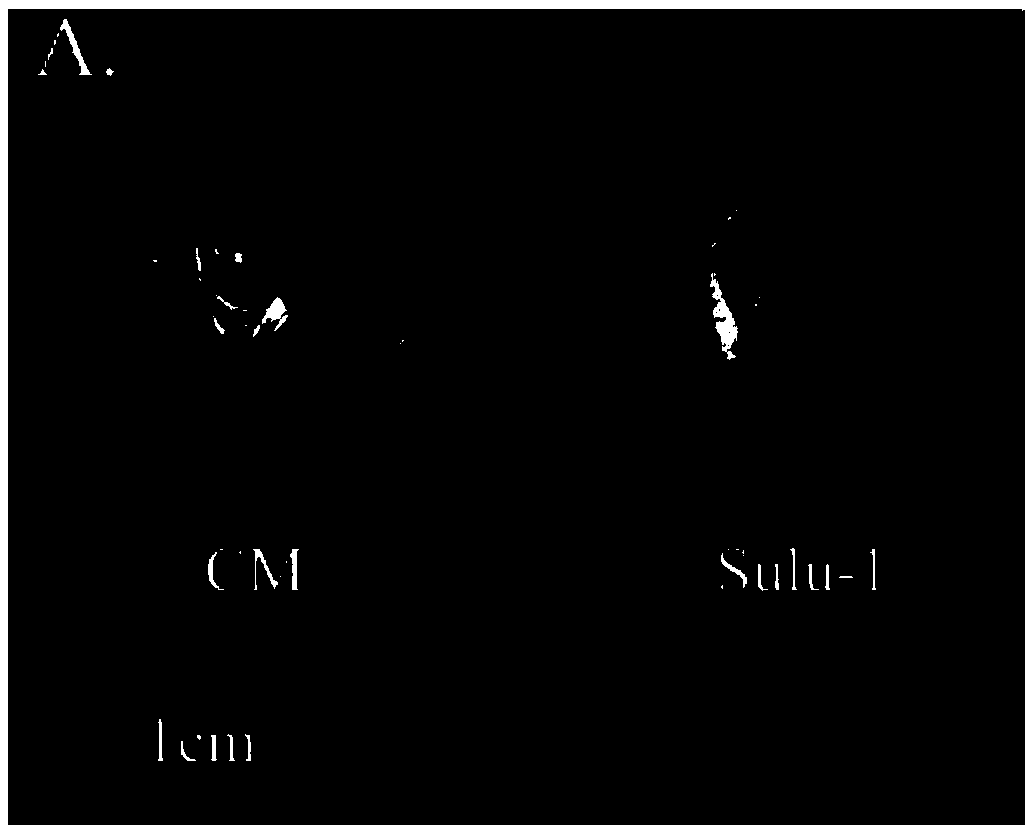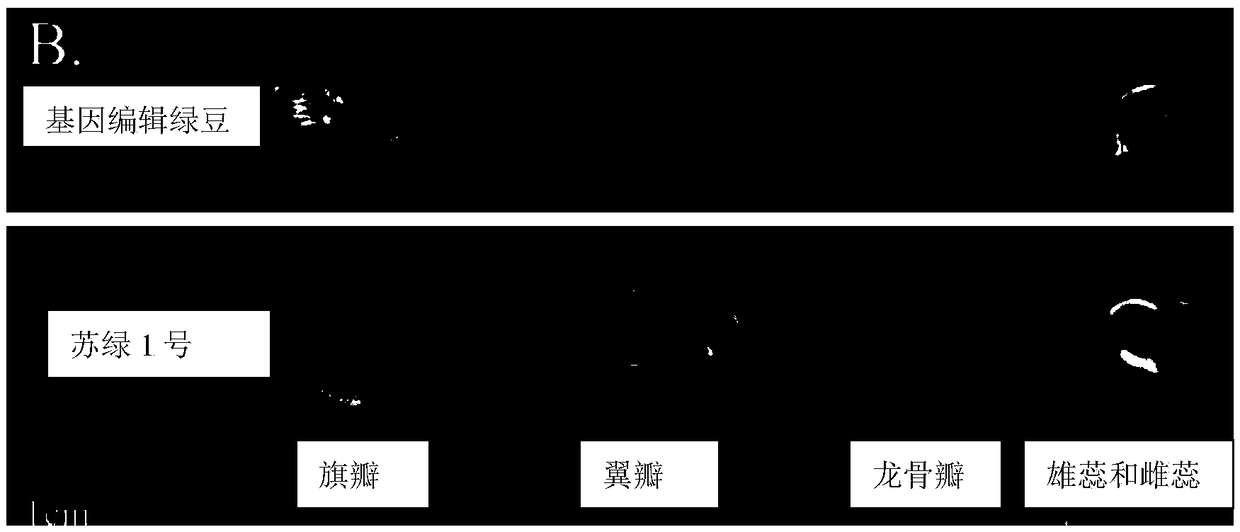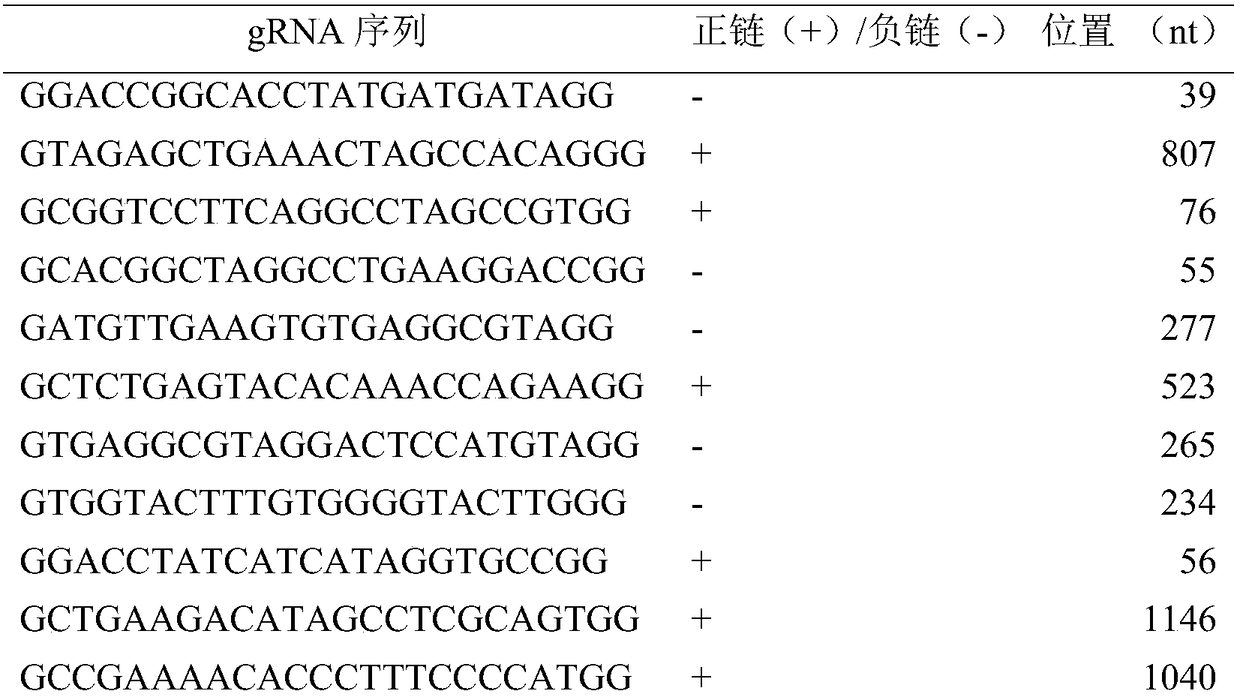Method for breeding mung bean flowering pollination mutant based on CRISPR/Cas9 gene editing technology and special gRNA
A gene editing and mutant technology, applied in the field of molecular breeding, genetic engineering and molecular biology, to achieve the effect of simple method and high success rate
- Summary
- Abstract
- Description
- Claims
- Application Information
AI Technical Summary
Problems solved by technology
Method used
Image
Examples
Embodiment 1
[0025] Embodiment 1 is used to edit the design of the gRNA of cha gene
[0026] According to the principle of CRISPR / Cas9 gene editing, the protospacer adjacent motif (PAM, "NGG", where "N" is any nucleotide) of the sequence of the gene cha shown in SEQ ID NO.1 is the gRNA. sequence. If the first nucleotide at the 5' end of the gRNA is not guanine (G), add a G to the 5' end, and the gRNA is 21 nt long. All gRNAs designed in gene cha are shown in Table 1. The gRNA sequence should be on the exon, not too close to the ATG initiator, and should be in the front and middle of the entire gene. The gRNA was compared to the mung bean gene green database (http: / / plantgenomics.snu.ac.kr / mediawiki-1.21.3 / index.php / Main_Page) by Blast, and the target sequence was determined to be unique on the mung bean genome.
[0027] Table 1 gRNA sequence
[0028]
[0029]
Embodiment 2
[0030] Embodiment 2 is used for the construction of the CRISPR carrier of editing cha
[0031] The framework of the CRISPR vector for editing cha is pYAO:hSpCas9 (Yan L, Wei S, Wu Y, et al. High-efficiency genome editing in Arabidopsis using YAO promoter-driven CRISPR / Cas9system[J].Molecular plant,2015,8( 12):1820-1823.), the construction method of the CRISPR carrier for editing cha is as follows:
[0032] Synthesize forward and reverse oligonucleotide chains 1) 5'-ATTG[20N or 21N]-3' and 2) 5'-AAAC[20n or 21n]-3'. Where "20N or 21N" is the gRNA sequence shown in Table 1, 20n or 21n is the reverse complementary sequence of the gRNA shown in Table 1, for example, the reverse complementary sequence of GGACCGGCACCTATGATGATAGG is CCTATCATCATAGGTGCCGGTCC. The gRNA specifically used in this example and Example 3 is the fifth sequence GATGTTGAAGTGTGAGGCGTAGG in Table 1.
[0033] Anneal the positive and negative oligonucleotide chains 1) and 2), the scheme is: a. dissolve the oligon...
Embodiment 3
[0040] Example 3 Transformation of mung bean plants with CRISPR plasmids
[0041] Referring to the method of Zhao et al. (2017), mung bean plants were transformed with the pYAO:hSpCas9-target-sgRNA plasmid mediated by magnetic nanocarriers. The plasmid of MNP (PolyMag1000, purchased from Chemicell) was diluted to 1 μg / μl with ultrapure water, mixed at 1:4 and incubated at room temperature for 30 minutes to form the MNP-plasmid complex. Add the MNP-plasmid complex to 1ml pollen medium (every 100ml contains 15g sucrose, 0.03g Ca(NO 3 ) 2 4H 2 O, 0.01g H 3 BO 3 ) among.
[0042] In the early morning, 100 mg of pollen was collected from the flower organs of mung bean and placed in a petri dish, and the MNP-plasmid complex suspension was added to fully infiltrate the pollen. Cover the petri dish and place it on a MagnetoFACTOR-24 magnetic plate (purchased from Chemicell) for 0.5 hour to perform magnetic pollen transformation. Then, the water in the upper layer was carefully ...
PUM
 Login to View More
Login to View More Abstract
Description
Claims
Application Information
 Login to View More
Login to View More - R&D
- Intellectual Property
- Life Sciences
- Materials
- Tech Scout
- Unparalleled Data Quality
- Higher Quality Content
- 60% Fewer Hallucinations
Browse by: Latest US Patents, China's latest patents, Technical Efficacy Thesaurus, Application Domain, Technology Topic, Popular Technical Reports.
© 2025 PatSnap. All rights reserved.Legal|Privacy policy|Modern Slavery Act Transparency Statement|Sitemap|About US| Contact US: help@patsnap.com



